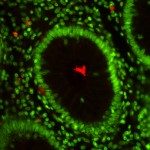Link to Pubmed [PMID] – 11169106
Mol. Microbiol. 2001 Feb;39(3):652-63
Type III secretion systems (TTSSs or secretons), essential virulence determinants of many Gram-negative bacteria, serve to translocate proteins directly from the bacteria into the host cytoplasm. Electron microscopy (EM) indicates that the TTSSs of Shigella flexneri are composed of: (1) an external needle; (2) a transmembrane domain; and (3) a cytoplasmic bulb. EM analysis of purified and negatively stained parts 1, 2 and a portion of 3 of the TTSS, together termed the “needle complex” (NC), produced an average image at 17 A resolution in which a base, an outer ring and a needle, inserted through the ring into the base, could be discerned. This analysis and cryoEM images of NCs indicated that the needle and base contain a central 2-3 nm canal. Five major NC components, MxiD, MxiG, MxiJ, MxiH and MxiI, were identified by N-terminal sequencing. MxiG and MxiJ are predicted to be inner membrane proteins and presumably form the base. MxiD is predicted to be an outer membrane protein and to form the outer ring. MxiH and MxiI are small hydrophilic proteins. Mutants lacking either of these proteins formed needleless secretons and were unable to secrete Ipa proteins. As MxiH was present in NCs in large molar excess, we propose that it is the major needle component. MxiI may cap at the external needle tip.

